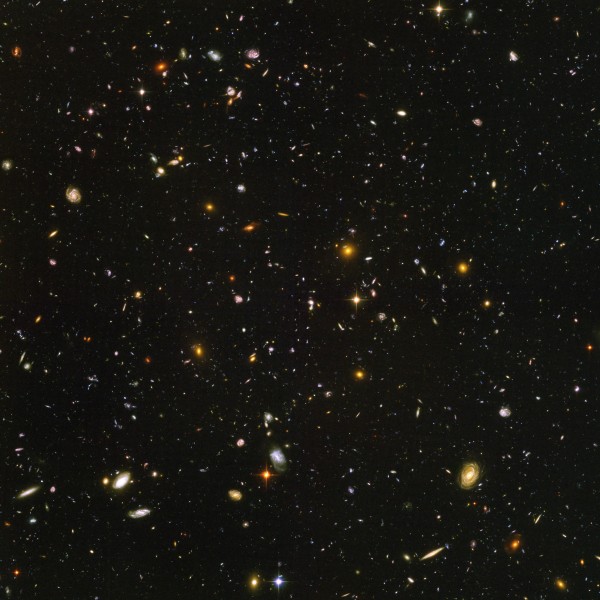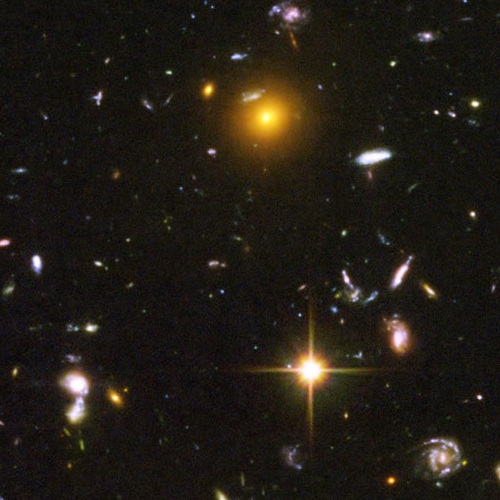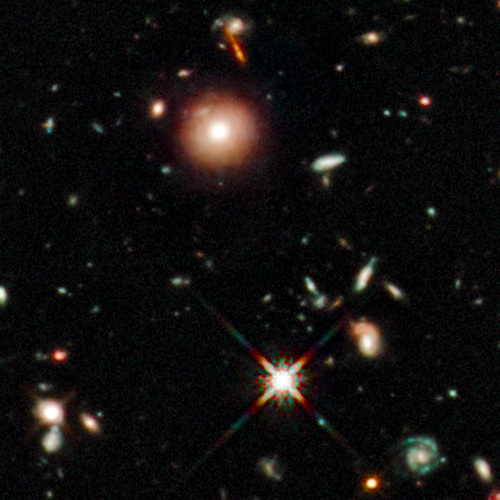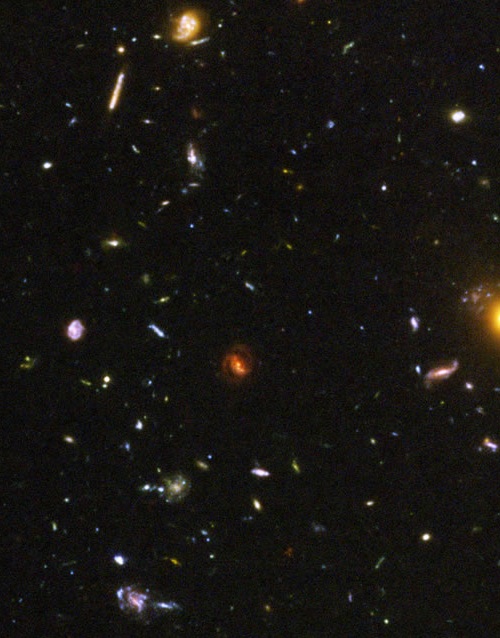They will see us waving from such great heights
"Come down now," they'll say.
But everything looks perfect from far away
"Come down now," but we'll stay. -Postal Service
We've been over this twice before, but here's a refresher on how you image the farthest galaxies in the Universe. Pick a spot in the sky that's empty. What does empty mean? When you look with your eyes, with binoculars, and even with a reasonable telescope, you find no bright stars, no bright galaxies, no nebulae, no clusters -- in short nothing -- except for the absolute faintest of objects.
You know, something like this substantial region, which has maybe six ultra-dim stars in it. (Which is a tiny, tiny number for a region as big as this.)

You then take the most powerful "picture-taker" that you have. For astronomy, that means the most light-gathering power (or largest mirror), the least atmospheric distortion (or, ideally, no atmosphere), and the best camera possible. Where do we go for the best combination of all three?

Well, we go to the Hubble Space Telescope! Years ago, with the old Wide-Field-Camera, Hubble took a look at this region, and just left the shutter open on the same region of the sky, taking picture upon picture of the same exact place. They then added the light from all of those images together, and produced an image known as the Hubble Ultra Deep Field (HUDF). It looks like this.

Fast-forward to the present day. Now, we've got the same light-gathering power, the same lack of atmosphere, but a brand new camera! This time, they used an infrared filter (instead of a visible light composite), and took a picture using the same exact method. First off, here's the result.

I don't want to just leave you these images, I'd like to show you the same exact regions on both of them, zoomed in, so you can really see the similarities and differences; they're really interesting. So, here you have a few of my favorite excerpts.
Old image...

versus new image...

and again with the old image (with a star, this time)...

and again with the new image (with the same star)...

and once last time with the old, in a long strip,

and finally once more with the new, in the same strip!

No words for how magnificent these images are. And -- just as a reminder -- this whole entire Ultra-Deep-Field image only views about one-one hundred thousandth of the sky! I could play with these all day long, but then where would the fun be for you? Download the ultra-high resolution versions of the old image and the new one, and go play yourself!
- Log in to post comments

The image quality of the "old" image looks better to me -- sharper, less noise, and I think I can see the odd faint galaxy (i.e. faint smudge of light) that isn't visible in the "new" image. It's an awesome image, but where's the improvement?
I'm with Len on this - it's hard for the untrained eye to see what the big deal is. To me, almost every feature visible in the new images appears to also be visible in the corresponding old image. What differences should we be noticing?
It would be helpful if the images were placed side-by-side, to be viewed stereoscopically (e.g. by crossing our eyes). With the images merged, the differences amount to color vision with a range of new colors we can't normally see.
The dynamic images of hubble seem to be a dynamic instrumentation, creating a hypotnuse angle transcending around the imagine and retracts the image with a ray of positive modern day proton ray of light across the super perplexities cross sectional dynamic negative atmospher, projecting a beam of positive light and thus retracting the images into a collinder of less restrictions, to formulate a transgressed illusive imagery system and dylutting the images, into a subjective notable logical collinder of a planetarium picture the atmospherical images disagree with images among the positive images, and surpass the imagination circutry of defined gravitational perplexity, and justifies the notional subjective images data colectional systems of logistics is a cylinder of high performances with the new technological cylinder of a collinder being transgressed after the picture with a magnetic adjustable lens with a barring lens of polaris capabilities to adjust the tempuratures using a cylinder of adjusted collected data systems to install a collendor of logistics, formating a formula of E=mc(sq), with out the speed concept just use the tree concept of notoriztional speed perplexities of reverse systems collecting data and illustrating a quantum perplexities into the collander, of logistics purifying the images, with out the justification, of quantum theory into the colander, is transforming the mind of images into a subjective data function, cross diagnal the lens into a nuero system responce system of sublettal interior subjective logistics into an ideal the dynamic lens will perform the ignition system of elite dynamic subjective notation inter twined with the absence of lenses if we were to correctivly constraint the energy to perform the re-dynamic simulator into a sublimable design syste to subjective thought interior subjective notational sublettal notations forming a diagnostic view of the x ray images without the ray of harm to perform the logistics as if it were a visible tunnel of the images, and secretly target the degree of images into a collective data justification note the dire need to see the images of scientific screening dimensional sublettal subjective images versus the cancerous images of space delusional secretions, anti matter interferrences, adjust the mirror instead of destroying images catoclisoms
@Len and Rosie
It doesn't look at impressive, but I think this has something to do with it:
http://en.wikipedia.org/wiki/Angular_resolution#Explanation
In general, using optics designed for visible light, your resolution is going to drop off in quality when you start to stray too far out of the bounds of the visible spectrum. You can see a pretty explicit statement of that for the infrared case in the equation at the end of the section.
Darrell W. morehouse thinks his word salad of nonsense is funny. It is actually just juvenile.
I got the images in Photoshop in two layers. I had to rotate one layer and move it to align it with other, using difference blend to get it pretty close to perfect. Now I can scroll around and flip back and forth from one layer to the other.
"For astronomy, that means the most light-gathering power (or largest mirror), the least atmospheric distortion (or, ideally, no atmosphere), and the best camera possible."
Isn't sky brightness (not distortion) the limiting factor for observing faint objects from within the atmosphere?
I gotta agree with posters 1 & 2 on this. Unless Ethan got the image files mixed up before posting, every single aspect of the old images is sharper than the new ones. There are more details to the galaxies in the older images, and significantly less fuzz overall. My own personal preference is for the first image in each pair. There may for whatever reason be more valuable scientific data in the second image of each pair, but as far as pretty pictures of space go, old images for the win, hands down.
I've spent the past few years trying to explore physics and figure out what I would be interested in doing--I've settled more towards energy research, somewhere between CM and MatSci, but I've tried at a variety of different things in the along the way. So my question for you is: How did you end up in AMO? Were there any other fields you might have gone into instead?
It's a little hard to compare them. One image is in AdobeRGB color space which doesn't display correctly in a Web browser. The other image is untagged so it has an unknown color space. Furthermore, we don't what processing was done to enhance the images. Most likely both images were treated differently. There are special sharpening techniques, different ways of noise reduction, even simple things like levels and curves, hues/saturation, the options are endless. Infrared is invisible. So we are seeing fake colors? Right?
Somebody should get these issues straigtened out before dumping them on the world. As I said before, they were not even rotated to match. I had to do that myself. How many people will bother?
Ethan, I am an undergraduate in mechanical engineering and your blog reminds me of the awe and fascination with astronomy that I felt when reading my first science books on stellar formation as a child.
Keep it up!
Especially with your dark matter themed updates. I've read a fair amount of introductory material on the topic and you do a great job summarizing the essential points, explaining the inadequacy of counterarguments, and bringing in relevant figures.
Okay, I just read an article in Sky & Telescope (skimmed it, actually) and I think I have an answer to my question.
The new picture is taken at infrared wavelengths, as has been pointed out, and this might account for the fuzziness as resolution decreases with increasing wavelength.
The point of using far-infrared is to detect galaxies at extreme red shifts -- these would represent the farthest ones in the picture and hence the oldest ones. Somewhere in the new picture are five or so galaxies that are not visible in the old picture due to being redshifted into the infrared. These are the galaxies we're looking for, because they give clues as to the early development of the universe.
So the *really* interesting features are those five reddish blobs -- time for a game of "Where's Waldo"!
Any corrections to the above would be most welcome.
Perfectpicturelighting.com provides a simple way to search through hundreds of styles of picture lights. While tremendously user friendly for individuals, the site and customer service is also specially designed for contract picture lighting needs, including picture lights for hotels, museums, galleries, churches, universities, and other public venues.
The dynamic images of hubble seem to be a dynamic instrumentation, creating a hypotnuse angle transcending around the imagine and retracts the image with a ray of positive modern day proton ray of light across the super perplexities cross sectional dynamic negative atmospher
Best line out of #4:
"...space delusional secretions..."
Now I am actually hoping a member of the opposite sex will try to end a relationship with the excuse of being smothered. Then I can tell her shes suffering from 'space delusional secretions' and therefor is not being smothered after all.